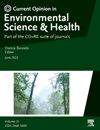哪些来源对亚硝胺及其在水资源中的前体的贡献更大:自然的还是人为的?
IF 6.6
Q1 ENVIRONMENTAL SCIENCES
Current Opinion in Environmental Science and Health
Pub Date : 2025-08-27
DOI:10.1016/j.coesh.2025.100664
引用次数: 0
摘要
本文综述了近年来在水资源中亚硝胺及其前体来源鉴定方面的研究进展。自然来源包括腐殖质物质、微生物和藻类代谢物,自然灾害和极端气候事件会加剧这一问题。人为来源包括生活废水、工业废水和农业废水。天然来源通常提供几到几十ng/L的前体,但提供很少的NAs,而人为来源提供几到数百ng/L的NAs和更高水平的前体。这些见解有助于区分自然和人为的贡献,为污染控制和水资源的可持续管理提供指导。本文章由计算机程序翻译,如有差异,请以英文原文为准。
Which sources contribute more to nitrosamines and their precursors in water resources: The natural or the anthropogenic?
This paper summarizes recent progress in identifying sources of nitrosamines (NAs) and their precursors in water resources. Natural sources include humic substances, microbial and algal metabolites, which will be exacerbated by natural disasters and extreme climate events. Anthropogenic sources include domestic wastewater, industrial wastewater and agricultural wastewater. Natural sources generally contribute a few to dozens of ng/L of precursors but provide minimal NAs, while anthropogenic sources provide a few to hundreds of ng/L of NAs and higher levels of precursors. These insights aid differentiation of natural vs. anthropogenic contributions, providing guidance for pollution control and sustainable management of water resources.
求助全文
通过发布文献求助,成功后即可免费获取论文全文。
去求助
来源期刊

Current Opinion in Environmental Science and Health
Medicine-Public Health, Environmental and Occupational Health
CiteScore
14.90
自引率
0.00%
发文量
92
审稿时长
114 days
 求助内容:
求助内容: 应助结果提醒方式:
应助结果提醒方式:


